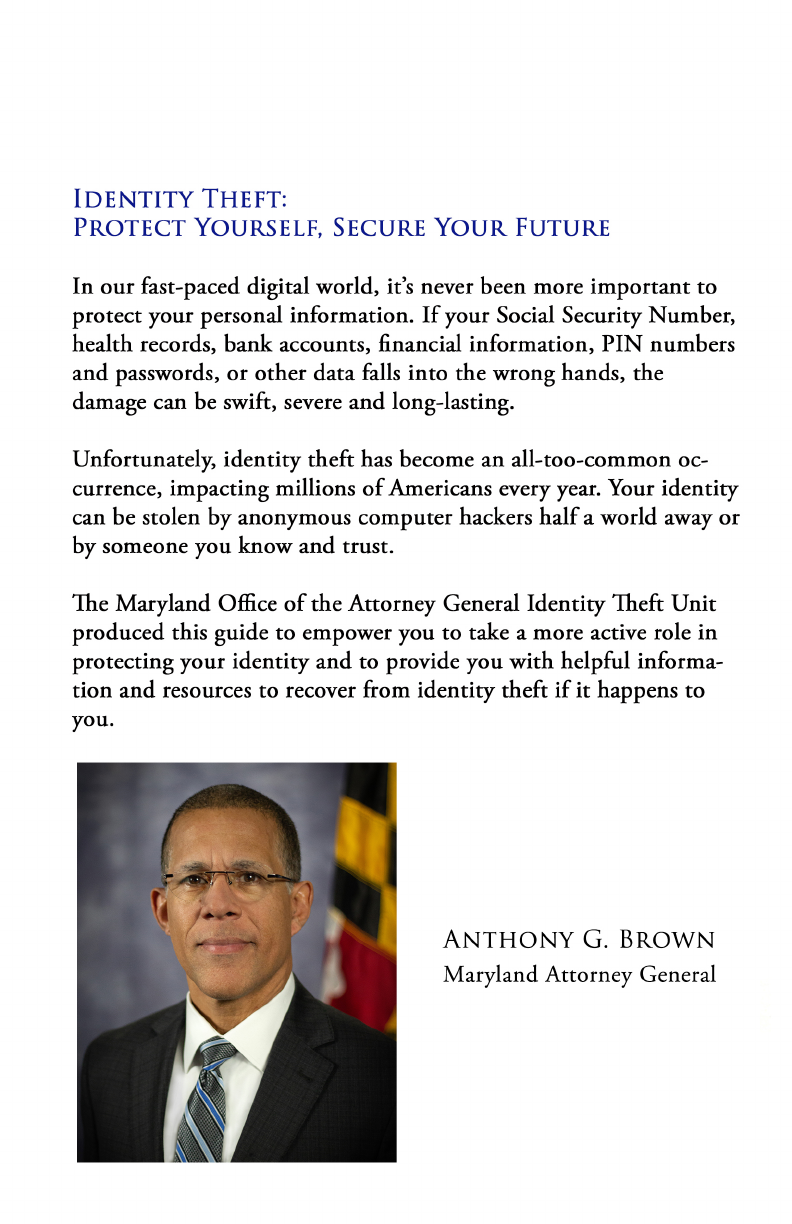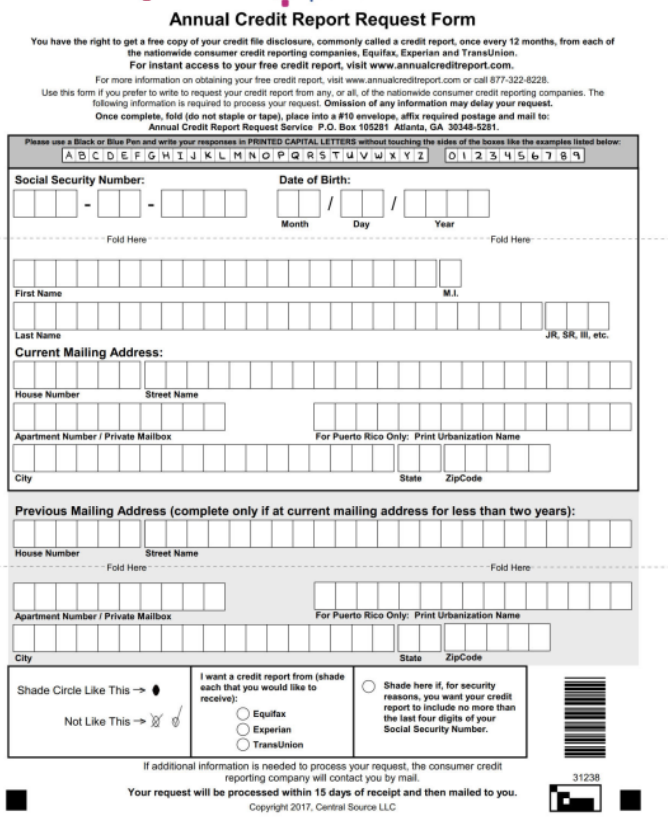

1
Contents
What Is Identity eft? ......................................................2
How Can I Avoid Becoming a Victim?
.............................8
I ink My Identity Has Been Stolen - What Can I Do?......14
Tools.................................................................................21
Maryland Oce of the Attorney General
Consumer Protection Division
Identity eft Unit
Identity
Theft:
Protect Yourself,
Secure Your Future

2
What Is Identity Theft?
Identity theft occurs when someone uses your personal information to:
• Purchase goods,
property, or services
without your consent;
• Create fake nancial
accounts in your
name;
• Impersonate you for
nancial gain or to
receive medical care;
• File fraudulent tax
returns under your
name to obtain your
refund; and/or
• Commit other crimes
that can damage your
personal credit and
reputation.
Identity theft is one of the
fastest growing crimes in the
country, aecting over 15 million Americans each year. Victims often
spend hundreds of hours and thousands of dollars to x the damage
caused by identity thieves.
is booklet will help you learn what identity theft looks
like and how it happens, how to reduce your risk of identity
theft, and give you specic guidance to help recover if your
identity is stolen. Look for this symbol for quick tips to help avoid
identity theft.
What Does Identity eft Look Like?
Identity theft can take many forms. Often, identity thieves like to

3
simply steal money. is is called nancial identity theft. Financial
identity theft generally takes one of two forms: existing account
fraud or new account fraud.
Existing account fraud is extremely common, and there is a good
chance you have already experienced it at some point in your life.
is type of fraud happens when an identity thief gains access to an
account that you created. For example, if an identity thief makes a
purchase using your stolen credit card number, you are a victim of
existing account fraud. Existing account fraud can be relatively easy
to spot, but dicult to prevent.
Diligently monitoring your account statements for
unauthorized activity is one of the best ways to spot
existing account fraud. Be sure to check your ac-
count statements at least once a month, but more frequently
if possible.
New account fraud occurs when identity thieves use stolen infor-
mation to create a new account in your name. By using your stolen
information (name, date of birth, or Social Security number, for

4
example), someone may be able to open a credit card or utility ac-
count in your name. is type of fraud can be very dangerous because
it may go undiscovered for many years. Victims often discover the
new accounts when they are contacted by a debt collection agency or
applying for credit.
New account fraud can be hard to spot, but it’s easy to prevent.
A free tool, called a credit freeze is extremely eective at prevent-
ing new account fraud. For more information about credit freeze,
see page 13. Checking your credit report annually from each of the
three major credit reporting agencies is a good way to see if an iden-
tity thief has fraudulently opened an account in your name. e
three major credit reporting agencies are Equifax, Experian, and
TransUnion. See page 17 for instructions on checking your credit
reports.
Check your credit report from all three major credit
reporting agencies at least once per year. Also
consider placing a credit freeze with all three credit
reporting agencies before identity theft happens. This is one
of the only preventative tools in the world of identity theft.
Other common forms of identity theft include medical, criminal,
and income tax fraud.
• Medical identity theft occurs when an unauthorized person
uses your personal information to receive medical care. is
is dangerous because it could negatively aect your insurance
rates, or potentially lead to an inaccurate diagnosis or dan-
gerous drug interaction.
• “Criminal” identity theft occurs when a person uses your
personal information in the commission of a crime, often as
an alias or during a trac stop.
• Income tax identity theft occurs when a person uses your
personal information to le a fraudulent tax return to obtain
a tax refund. e identity thief will submit phony tax infor-
mation to receive a large tax refund in your name.

5
Identity thieves seem to be endlessly inventive. As a result, the list
of miscellaneous forms of identity theft is ever-growing. If identity
thieves can nd a way to benet from using your stolen information,
they will. Common examples include government benets, Social
Security payments, jobs, apartment rentals, student loans, utility
accounts, and much more.
How Does Identity eft Happen?
Identity theft happens when identity thieves obtain your personal in-
formation. ey can do this in one of three ways: they steal it, obtain
it from publicly shared social media, or trick you into giving it away.
Identity thieves can
steal information in many
ways. Some methods, like
physically stealing your
wallet or purse, don’t rely
on technology. Physically
stealing your information
can limit identity
thieves to a par-
ticular location or
a limited number
of stolen les. Other
methods, such as hack-
ing into your email or
a business database can
happen from anywhere in
the world using
sophisticated
technology. Steal-
ing data from a
government or
business database is sometimes called a “data breach.” Data breaches
can allow a single person to steal a massive amount of information.
For more information on data breaches, see page 6.

6
Consider that what you post on social media sites is
visible to many people, not necessarily just your
close friends. Be cautious about posting information
(like your birthday or birthplace) that could help an imposter
steal your identity.
Identity thieves can also use information that you gave away. Be
mindful about what you publicly post on social media because iden-
tity thieves can search out useful information even if you think it’s
harmless to share. For example, it may seem harmless to post your
birthday on a social media site, but thieves can use this information
with other information about you to steal your identity. More com-
monly, however, identity thieves use fraud to trick you into giving
away private information. Some of the most common ways to trick
you into giving away valuable information are scams called “phishing”
and “imposter fraud.” More information about these and other types
of scams is available on the Maryland Attorney General’s website,
www.marylandattorneygeneral.gov, by clicking on Services, and then
Consumer Protection.
What Are Data Breaches?
A data breach occurs when sensitive or condential information has
been accessed, viewed, stolen, or used by an unauthorized individual.
Data breaches, also called security breaches, can expose your personal
information, such as Social Security numbers, nancial account infor-
mation, user names and passwords, medical records, and more.
A data breach can occur when a business’s website is hacked, a com-
puter is stolen, data tapes or other records are lost in the mail, or
through an unintentional release of private information. e Mary-
land Personal Information Protection Act (PIPA) requires any busi-
ness that keeps electronic records containing the personal information
of Maryland residents to notify those residents if their information
is compromised. e business must also provide notice to the Oce
of the Attorney General. is enables Marylanders to protect them-

7
selves from fraud and identity theft. ese notices are posted on the
Attorney General’s website under “Security Breach Notices,” and are
searchable by the business’s name.
Take it seriously if you receive a notice from a busi-
ness that they have experienced a data breach and
your personal information may be at risk of being
exposed or stolen. If you have any questions about the au-
thenticity of the notice, reach out to the Attorney General’s
Identity Theft Unit at [email protected]
or 410-576-6491.
Often a business that has experienced a
data breach will
oer comple-
mentary credit
monitoring ser-
vices. Consider
taking advantage of the oer if, after you
review its details, you think it will be bene-
cial. Contact the business that is extending
the oer, the credit monitoring agency, or
the Attorney General’s Identity eft Unit if
you have additional questions about credit monitoring services.
To further minimize the risk of identity theft following a data breach,
consider changing your user name and password and, if the breach
involved a bank or other creditor, requesting new credit or debit card
account numbers.

8
If you have received a data breach notice, use this checklist to help
reduce your risk of becoming a victim of identity theft.
Place a fraud alert with each of the three major credit reporting
agencies (page 15).
Obtain a copy of your credit report from each of the three major
credit reporting agencies (page 17).
Make appropriate changes to your impacted information
(change passwords, cancel cards, or close accounts, for example).
Take advantage of any free credit monitoring oers provided by
the aected business.
Keep detailed records of all communications related to
the incident.
Consider placing a credit freeze on your credit reports (page 18).
How Can I Avoid Becoming a Victim?
You can’t eliminate the risk of identity theft. However, you can reduce
your risk by taking certain steps to protect your private information.
Protecting Yourself at
Home
Although identity thieves can
strike from the other side of
the world, it’s important to
secure information in your
own home, because it’s likely
where you spend most of your
time and keep many of your
sensitive documents. Some
identity thieves know or have a
relationship with their victim.
For example, party guests
or neighbors may be able to
physically steal documents
from you that are left unse-

9
cured. Mobile smartphones with cameras eliminate the need to actu-
ally steal your documents—the identity thief can simply capture the
information in a quick photograph. Follow these tips to help protect
your information at home.
• Shred sensitive documents you no longer need, such as credit
card oers, nancial statements, and medical documents;
• Use a locking mailbox;
• Use a safe or locked le storage system to protect sensitive
documents;
• Opt out of pre-screened credit card oers by calling
1-888-5-OPT-OUT (1-888-567-8688) or visiting
www.OptOutPreScreen.com; and
• Opt out of “bulk” mail by visiting www.DMAChoice.org.
Keep your sensitive documents in a locked, secure
location in your home. Thieves no longer need to
physically steal your paperwork—they can just take a
photo of it with a smart device, like a phone or tablet.
Protecting Yourself on the Go
It’s easy to accidentally—and unnecessarily—carry sensitive informa-
tion in your purse or wallet. Unless you specically need the informa-
tion for a job interview or an appointment, you should leave your
Social Security card, bank account PIN, insurance cards, and other
important documents in a secure place at home. You may also want
to make copies of important documents, including your credit
cards (front and back), Social Security card, and insurance cards. If
your purse or wallet is stolen, you will have all the information at
home if you need to replace cards or close your accounts.
Don’t give out your Social Security number unless it’s absolutely
necessary. Sometimes you will be required to use your Social Security
number for tax purposes, Medicare, or to request a credit report from
a credit agency. If you have a membership card that uses your Social
Security number, ask for a randomly generated identication number

10
instead.
Protecting Yourself Online
Protecting your sensitive information online is be-
coming more and more dicult. Technology makes
it very easy for identity thieves to steal both your
money and information through “phishing.” Phish-
ing occurs when identity thieves send emails that
appear to be from a trusted source (your bank, a
utility service provider, or a friend, for example)
in an eort to trick you into providing private
information. Often, these emails use stolen or
counterfeit graphics, and may ask you to
“conrm” a password or other sensitive
account information, enter payment
information, or open an attachment.
Keep these tips in mind to protect
your information online:
• Financial institutions never ask
for personal information by
email;
• Don’t click on links in unfamiliar
emails. ose links can contain a virus or
malicious software that can infect your computer; and
• Delete any suspicious emails immediately.
A Note About Passwords
It’s nearly impossible to keep track of all the unique passwords we use
online, so here are a few ways to keep your accounts more secure.
Consider using multi-factor authentication (MFA), which requires
your password AND an additional piece of information to access the
account. Usually the additional piece of information is a short code
sent to a smartphone, email, or other trusted device. Even if someone
is able to successfully guess your password, they will be unable to
access your account unless they also have the second piece of informa-
11
tion required.
Do NOT use the same password for multiple sites! If one website
is hacked, and the identity thieves learn your password, they may be
able use it on other accounts if you reuse the same passwords.
Write down clues or reminders rather than your actual passwords if
you have trouble remembering them. Compare the following remind-
er phrases like “my third dog and dad’s birth year” versus “Spot1950.”
One will be meaningful to you, but meaningless to someone who
may view the written clue.
Consider using fake answers for password recovery questions. If you
have ever forgotten your password, you know that many online ac-
counts will ask you a series of questions to recover your password.
If you have a prominent social media presence, or you suspect an
identity thief knows a lot about you, you can use nonsense answers
for your recovery question. For example, “Where did you grow up?”
is a common recovery question. Many people that know you or have
access to your personal information may be able to accurately answer
that question. However, if you put something that’s clearly not true
( “e Moon,” for example), it will be much harder for an identity
thief to compromise your account.
What Are Credit Reports?
ere are three major nationwide credit reporting agencies: Equifax,
Experian, and TransUnion. Credit reporting agencies collect and
maintain information about consumers and their nancial history in
something called a “credit report.” Credit reports are used to generate
something called a “credit score,” which is often used by lenders and
creditors to decide whether to provide you with a service and if so,
on what terms (for example, interest rates). Generally, a better credit
score results in more access to lender and creditor services, and on
more favorable terms.
While a credit score is important, the underlying information on a
credit report is what determines a credit score. erefore, it’s impor-

12
tant that your credit report is accurate and free from fraud. A credit
report includes some personal information as well as your nancial
history, such as whether you pay your bills on time and if you have
led for bankruptcy.
If you are a Maryland resident, you can receive up to
six free credit reports each year. Federal law entitles
you to one free report from each credit reporting
agency each year, and Maryland law entitles you to an addi-
tional free report from each credit reporting agency each
year.
You may request a free copy of your credit report from each of the
three major credit reporting agencies once a year. is is one of the
easiest and most eective ways to see if you are a victim of identity
theft, specically new account fraud (page 3). Maryland residents
are entitled to an additional free credit report each year, which can be
obtained by directly contacting any of the three credit reporting agen-
cies. You can also obtain free credit reports through Annual Credit
Report, an organization authorized by federal law to provide credit
reports from Equifax, Experian, and TransUnion. See page 17 for

13
instructions on obtaining your credit reports.
How to Protect
Your Credit Report
You can completely
block the information
on your credit report
from would-be credi-
tors or lenders through a
credit “freeze.” Freezing
your credit report is one
of the only ways to help
prevent identity theft. If
you have a credit freeze
in place, any new ac-
count opened in your name must get your approval. In other words,
you are the one who decides what accounts can be opened in your
name, rather than a creditor or lender making that decision.
Most businesses will not open credit accounts without rst checking a
consumer’s credit history through a credit report. Even someone who
has your name and Social Security number might not be able to get
credit in your name if your credit reports are frozen. You can freeze
your credit reports at no cost.
While a credit freeze can help protect against identity theft, it may
not be for everyone. If you plan to apply for a credit card or to rent
an apartment in the near future, it’s likely that your credit report will
need to be accessed and you will need to lift the freeze (this also called
a “thaw”).
You can also freeze the credit of a minor dependent, which can
help protect them against fraud and identity theft.
In 2012 Maryland became the rst state in the nation to give parents
or guardians the ability to freeze a child’s credit report so that the
child is not victimized before they turn 18. When parents or guard-

14
ians take advantage of this opportunity, they can ensure a child will
begin their adult life with a clear credit history. is law extends pro-
tection to other consumers who meet certain eligibility requirements.
Contact the Attorney General’s Identity eft Unit at 410-576-6491
to nd out who may be eligible for this protection.
To place a credit freeze for your child, a parent or guardian must sub-
mit this information to the addresses listed below:
• e requestor’s complete name, address, and any of the fol-
lowing: a copy of a Social Security card, an ocial copy of
a birth certicate, a copy of a driver’s license or any other
government-issued identication, or a copy of a utility bill
that shows the requestor’s name and home address; AND
• e child’s complete name, address, and any one of the forms
of identication listed above.
Experian Security Freeze, P.O. Box 9554, Allen, TX 75013
Equifax Security Freeze, P.O. Box 105788, Atlanta, GA 30348
TransUnion LLC, P.O. Box 2000, Chester, PA 19022
I Think My Identity Has Been Stolen—
What Can I Do?

15
If any of the following have happened, you may be a victim of iden-
tity theft:
• Your bank or credit card statements never arrive in the mail;
• You receive acknowledgments of new accounts opened that
you don’t recognize;
• You receive calls from collection agencies demanding payment
for accounts you never opened or purchases you never made;
• ere are mysterious charges on your credit card bill;
• Accounts that you didn’t open appear on your credit reports;
• ere are excessive credit inquiries or any unfamiliar activity
on your credit reports;
• You are denied credit or oered less favorable credit terms,
such as high interest rates; or
• Law enforcement has warrants for a crime committed in your
name.
Treat any unfamiliar activity in your account state-
ments, credit reports, or mail as suspicious. Don’t
assume the unfamiliar activity is an error and will go
away on its own.
Identity eft Recovery Steps
If you are—or think you may be—a victim of identity theft, follow
these six steps for the best chance of recovering your nancial standing.
Keep detailed records of your identity theft resolution
process. Disputing identity theft can take weeks or
months, and it’s easy to lose track of with whom you
spoke or what information they gave you.
Place a Fraud Alert on Your Credit Reports
(Please note: this is not the same thing as a “credit freeze”)
When you rst become aware that you may be the victim of iden-
tity theft, you should immediately place a fraud alert on your credit

16
report and request a copy of your credit report by calling one of the
three credit reporting agencies (see contact information, below).
Whichever agency you call is required by law to notify the other two.
A fraud alert lasts for one year, and can be renewed by calling any of
the credit reporting agencies. Review your credit report for any un-
usual activity, especially accounts in bad standing. Often your credit
report is the only way to detect accounts in your name that were
opened fraudulently.
Equifax
888-766-0008
www.alerts.equifax.com/AutoFraud_Online/jsp/fraudAlert.jsp
Experian
888-397-3742
www.experian.com/fraud/center.html
TransUnion
800-680-7289
www.transunion.com/personal-credit/credit-disputes/fraud-alerts.page

17
Report the Crime to Police
Report the crime to your local law enforcement agency.
Maryland law requires your local police to take a report
of identity theft and give you a copy regardless of where in the world
the crime occurred (Md. Code, Criminal Law, Article §8-304).
Get Free Credit Reports
A credit report includes some personal information
as well as your nancial history, such as whether you
pay your bills on time and if you have led for bankruptcy. Credit
reporting agencies sell the information in your report to creditors,
insurers, employers, and other businesses that use it to evaluate your
applications for credit, insurance, employment, or renting a home.
You may request a free copy of your credit report from each of the
three nationwide credit reporting agencies—Equifax, Experian and
TransUnion—once a year; Maryland residents may request one addi-
tional report each year at no cost. is is one of the easiest and most
eective ways to prevent identity theft.
ere are three ways to request your credit reports:
• Phone: 1-877-322-8228
• Online: www.annualcreditreport.com
• Mail: See attached form on page 21.
Note: rough April 2021, three nationwide credit reporting agen-
cies—Equifax, Experian and TransUnion—are oering free weekly
online credit reports. e free weekly credit reports are only available
through www.annualcreditreport.com.

18
Contact the Federal Trade Commission
Report the fraud to the Federal Trade Commission by
calling 1-877-438-4338 or go online to www.identi-
tytheft.gov. You can compile a record of what happened in a central
document, called an Identity eft Report, through this site. e
report can be useful when disputing fraudulent accounts or charges
(see the sample dispute letter on page 22).
Dispute Fraudulent Accounts
Many businesses have established policies and proce-
dures for dealing with identity theft victims. If you have
trouble closing fraudulent accounts, disputing charges on existing ac-
counts, or need sample dispute letters, contact the Attorney General’s
Identity eft Unit.
Write to collection agencies that are demanding payment and
inform them that you are a victim of fraud, and are not responsible
for the payments. Include a copy of your police report, an identity
theft adavit that you may have lled out, and any other support-
ing documents.
See page 22 for a sample dispute letter that you can use as a template.
Consider a Credit Freeze
(Please note: this is not the same thing as a “fraud alert”)
A credit freeze (sometimes called a security freeze) com-
pletely blocks the information on your credit report from would-be
creditors or lenders.
Most businesses will not open credit accounts without rst checking
a consumer’s credit history. Even someone who has your name and
Social Security number might not be able to get credit in your name
if your credit les are frozen. You can freeze and thaw your credit
reports at no cost.
19
If you decide to obtain a credit freeze, you will need to contact each
of the credit reporting agencies.
Equifax
• Phone: 1-888-298-0045
• Online: www.equifax.com/personal/credit-report-services
• Mail: Equifax Security Freeze, P.O. Box 105788, Atlanta, GA
30348
Experian
• Phone: 1-888-397-3742
• Online: www.experian.com/freeze/center.html
• Mail: Experian Security Freeze, P.O. Box 9554, Allen, TX
75013
TransUnion
• Phone: 1-888-909-8872
• Online: www.transunion.com/credit-freeze
• Mail: TransUnion LLC, P.O. Box 2000, Chester, PA 19022
If you are requesting a credit freeze by mail, you will need to include
all of this information:
• Your full name, address, Social Security number, and date of
birth;
• Prior addresses and proof of prior names, if you have moved
or had a name change in the past ve years;
• A copy of a government-issued ID card; and
• A copy of a bank statement or utility bill conrming your
current address.
Other Forms of Identity eft
ere are additional steps you can take to help recover if any of the
following forms of identity theft happen to you.
20
Tax Fraud
• Federal: Contact the Internal Revenue Service Identity Protec-
tion Specialized Unit at 1-800-908-4490.
• Maryland: Contact the Questionable Return Team at the
Maryland Oce of the Comptroller at 410-260-7449.
Student Loans
• Contact the school that opened the loan and explain that you
are a victim of identity theft. Ask to close the loan and follow
their instructions on what they will need from you to dispute
the loan.
• If the fraudulent loan is a federal student loan, contact the
U.S. Department of Education Oce of Inspector General
hotline at 1-800-MISUSED (1-800-647-8733) or the U.S.
Department of Education Federal Student Aid Ombudsman
at 1-877-557-2575.
Checking Accounts
• Order a free copy of your ChexSystems report, which com-
piles information about your checking accounts. To get your
ChexSystems report, call 1-800-428-9623.
• If someone is writing bad checks against your account, con-
tact your nancial institution. Report the stolen checks, close
your account, and ask your nancial institution to report the
fraud to the check verication system.
• Contact check verication companies Telecheck (1-800-
710-9898) and Certegy (1-800-237-3826). Report that your
checks were stolen and ask them to tell businesses to refuse
the stolen checks.

21
Tools
Additional Resources
22
Sample Dispute Letter
[Date]
[Your Name]
[Your Address]
[Your City, State, Zip Code]
[Name of Company]
[Fraud Department]
[Address]
[City, State, Zip Code]
[RE: Your Account Number (if known)]
Dear [Name of Company]:
I am a victim of identity theft. I recently learned that my personal
information was used to open an account at your company. I did not
open or authorize this account, and I request that it be closed imme-
diately. Please send me written conrmation that I am not responsible
for charges on this account, and take appropriate steps to remove
information about this account from my credit les.
I have enclosed a copy of my Identity eft Report and proof of my
identity. I also have enclosed a copy of my police report. When you
receive a request like this with an Identity eft Report, you must
stop reporting fraudulent debts to credit bureaus.
Please send me a letter explaining your ndings and actions.
Sincerely,
[Your Name]
Enclosures: [List what you are enclosing] • Identity eft Report • Proof
of Identity [a copy of your driver’s license or state ID] • Police Report

23
Identity Theft Prevention
Checklist
Check your credit report annually.
Consider placing a credit freeze for yourself and family
members.
Monitor nancial statements and health records for suspicious
activity.
Opt out of junk mail and pre-screened credit card oers.
Enroll in the Do Not Call Registry.
Keep sensitive documents in a locked, secure location.
Shred documents containing personal information that you no
longer need.
Be very suspicious of unexpected calls from someone demand-
ing money or personal information.
Don’t post information online that could help an imposter
steal your identity.
Keep your computer’s virus protection software up-to-date.

24
Notes

